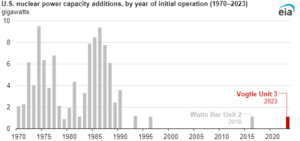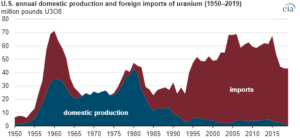In 1942, the race was on.
Physicists of America’s Manhattan Project were feverishly working to build an atomic bomb before Nazi Germany.
But they faced a critical challenge…
Their supply of uranium needed to be “enriched.” It needed to be transformed into nuclear fuel, an essential step in demonstrating the feasibility of constructing an atomic weapon. Without enriched uranium, no chain reaction would be possible… No chain reaction, no nuclear power..
And history certainly would’ve turned out very differently if the Third Reich developed an "A-bomb" first.
Eight decades later, Americans are in another race for uranium… And it could reshape the country for the next 80 years…
While working underneath the bleachers of Stagg Field at the University of Chicago, on December 2, 1942, Manhattan Project scientists achieved the world's first sustainable chain reaction. This lead to one of the most transformative events of the 20th century.
With that, the world’s first nuclear reactor kicked off the Atomic Age…or at least the ”Age of Atomic Destruction.”
You see, it wouldn’t be until 1951 that a nuclear reactor could produce a usable amount of electricity. From that point, it took another 17 years until the first nuclear power plant construction began 1968.And six years after that before commercial operation started in Arkansas.
Fast forward to today, and roughly 20% of U.S. electricity generation is born from nuclear. But that’s starting to change.
Nuclear – the New “Green” Energy
As the first new U.S. nuclear power reactor since 2016 begins operations, more Americans than ever say they favor expanding nuclear power, according to a recent Pew Research Center survey.

In fact, that number has grown from 43% in 2020 to 57% as more American's realized that it’s a clean and safe alternative energy that produces zero carbon emissions.
But now, after years of regulation and dependence on foreign nations, the U.S. has one big problem that could prevent the resurgence of nuclear power.
Since the 1980s, U.S. uranium concentrate production has collapsed from 43 million pounds at its peak to essentially nothing.
In 2018, the country purchased 40 million pounds of uranium from foreign suppliers. And near the top of that list… Russia.
 With elevated U.S. inflation and restarting domestic reactors, combined with sanctions on Russia, spot prices of uranium have rocketed over 100% since mid-2021. Adding to the demand pressures are the U.S. government's net-zero aspirations, as well as Japan and France restarting their own nuclear reactors.
With elevated U.S. inflation and restarting domestic reactors, combined with sanctions on Russia, spot prices of uranium have rocketed over 100% since mid-2021. Adding to the demand pressures are the U.S. government's net-zero aspirations, as well as Japan and France restarting their own nuclear reactors.
This is forcing America’s hand…
The Great “Onshoring”
In 2022 the U.S. government took a decisive stance.
A month after the invasion of Ukraine, it banned Russian oil and gas imports.
But cutting off the flow of Russian uranium imports was put on the backburner. That’s because the country provides a critical 15% to 20% of U.S. nuclear fuel.
It’s been more than a year since Russia launched its brutal attack on Ukraine. And Congress is finally ready to reduce America’s reliance on Russia and other foreign powers for uranium.
Last month, the Senate took an essential step toward bolstering domestic uranium supply chains, all in a bid to displace Russian supplies..
The National Defense Authorization Act passed, which includes an amendment targeting U.S. uranium production and enrichment.
It requires the Department of Energy (DOE) to acquire at least 100 metric tons per year of low-enriched uranium and enter at least two new contracts by the end of 2026. It also instructs the DOE to begin gathering at least 20 metric tons per year of high-assay low-enriched uranium (HALEU) starting in 2027, utilizing only uranium "produced, converted, enriched, deconverted, and reduced" in the U.S. Or if that’s not possible, a country "that is an ally or partner of the United States."
This proposal would be a win-win for America's national security and climate goals.
It’s important to note that this measure passed nearly unanimously. That suggests it should be included in the final bill to be signed into law later this year.
.The U.S. currently spends nearly $1 billion annually on Russian uranium. And bringing those dollars back could be a massive windfall for American corporations.
The Energy Your Portfolio Needs
Almost eight decades later, the industry looks vastly different.
Now, the goal is to make all this uranium “onshoring” take place. And several companies are already seeing the benefits.
Canada’s Cameco Corp (CCJ), the largest North American uranium miner and a key provider of other nuclear services, is acquiring a stake in Westinghouse Electric Co. Westinghouse takes enriched uranium and makes fuel rods. The deal values the US-based company at about $8 billion.
Meanwhile, shares of Cameco are up more than 50% over the last several months.
At the same time, we have Uranium Energy Corp (UEC) also capturing U.S. market share. The company won a contract with the DOE to Supply 300,000 pounds of uranium. It has several permitted projects in Texas and Wyoming. And shares of UEC have been on a tear, up 83% in recent months.
Urenco - another major player nuclear - is owned by several multinational conglomerates, including RWE AG (RWEOY) and E.ON S.E. (EONGY). It’s building up its facilities and controls 50% of the U.S. market as a refiner.
Nuclear energy is seeing a resurgence.
And that's not about to slow down any time soon. Particularly, given the geopolitical need for uranium.
Looking to dedicate a portion of your portfolio to the industry? Check out Sprott Uranium Miners ETF (URNM) or Global X Uranium ETF (URA). These are great ways to gain exposure to this hot industry. These exchange-traded funds hold some of the most well-known uranium companies in the world, making it easy to invest in this long-term trend.
While there may be bumps in the road, given the time it takes for bills to pass and nuclear facilities to be built, America’s nuclear sector is on the path of sustained growth.
Until next time,



